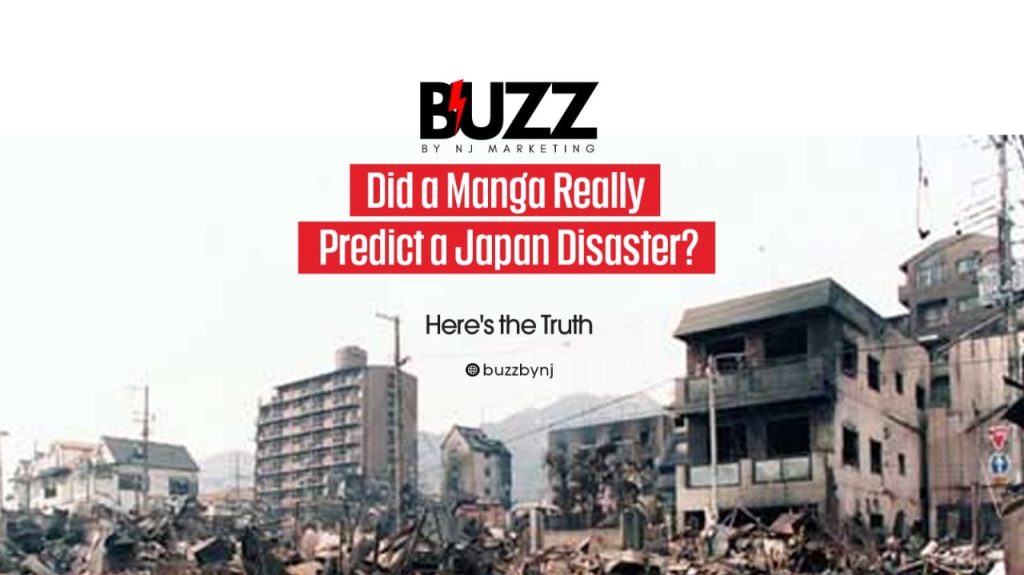It all began with a single manga panel depicting extensive devastation, with the year “2025” printed menacingly next to it. The image quickly went viral on sites like Reddit, X (formerly Twitter), and TikTok because recent earthquake activity in Japan was already making headlines.
Tourists began posting cancellations. Some speculated about a government cover-up. Others started tying the theory into real-world seismic warnings.
The manga in question? It’s not even new. The panel is from a long-gone graphic novel. Part of a dramatized portrayal of what an earthquake might look like in the future, the scene is completely fictitious. No insider information, no scientific prediction, and no proof that the artist was making any predictions.
But that didn’t stop the theory from spiraling.
The Manga Behind the Panic – Fiction Misread as Forecast
The drama Tokyo Magnitude 8.0, which imagines the chaos after a major earthquake in Tokyo, is the title that is being misunderstood. Like a lot of good fiction, it’s intense, emotional, and meant to provoke thought.
What people are missing is as follows:
- The “2025” timestamp is part of the storyline, not a real-world claim.
- The disaster scenario is a what-if narrative, not a prophecy.
- There is no evidence that the author had any seismic data or insight into future events.
In short, the entire theory that this manga “predicted” a 2025 earthquake is a misreading of art. It’s the equivalent of watching a sci-fi film set in 2050 and assuming that world events are being predicted.
Why We Love to Believe in Predictions
- This isn’t the first time fiction has been mistaken for foresight. We’ve seen this happen before:
- The Simpsons is constantly accused of “predicting” global events.
- Nostradamus is dragged out every time there’s a global emergency.
Conspiracy theorists blamed everything from video games to anime for purported warnings following the 2011 Fukushima accident.
Here’s the psychology behind it, though: people search for clues when their actual fears become too much to handle. We want to think there’s a pattern, a way to predict catastrophe before it occurs. The idea that someone or something anticipated what was going to happen is reassuring.
It’s human. But it’s not evidence.
What the Experts Say About Earthquake Risk in Japan
To be clear: Japan is at risk for earthquakes. Always has been. It is located in the geologically active Pacific Ring of Fire, where tectonic plate movements occur regularly. It is a well-established fact that there is a risk of seismic activity.
However, forecasting the precise moment of an earthquake? That isn’t feasible.
The Japan Meteorological Agency and international seismology specialists say:
- The likelihood of an earthquake can be calculated, but precise dates cannot be predicted.
- There is currently no way to predict whether an earthquake will strike in a given year, including 2025.
- There is currently no official warning that an earthquake is imminent in Japan in 2025.
Therefore, treating a manga as a valid prediction model is completely incorrect, even though it’s a good idea to be aware of potential risks and stay updated via Japan earthquake updates.
How Misinformation Snowballs, and Why It Matters
So, how did a harmless manga panel become global news?
It’s a familiar formula:
- One image goes viral.
- Fear kicks in.
- People stop checking sources.
- Speculation becomes “truth” in the comment section.
We live in a content economy where shock value drives clicks. Combine that with the anxiety many feel around natural disasters, and the result is a perfect storm of fear-driven engagement.
But this kind of misinformation isn’t harmless. It:
- Disrupts tourism
- Fuels public anxiety
- Undermines trust in scientific institutions
We’ve already seen tourists cancel plans over this theory. That’s not just an overreaction, it’s a consequence of not knowing how to verify information.
How Japan Actually Prepares for Natural Disasters
Here’s something worth going viral: Japan is one of the most disaster-prepared countries on Earth. Earthquakes are treated not as surprises, but as certainties to be planned for.
Here’s how Japan actively protects its people:
- Advanced early warning systems detect tremors seconds before they hit.
- Public education campaigns are ongoing, starting from elementary school.
- Seismic-resistant architecture is standard in residential and commercial buildings.
- Multilingual alerts and guidance are readily available for foreign visitors.
The country’s disaster preparedness is a model studied and adopted by other nations. That’s not fiction. That’s a fact.
Is It Time to Postpone Your 2025 Trip to Japan?
The short answer is no.
The longer answer is that there is no reason to avoid visiting Japan in 2025 because of earthquake concerns related to a manga unless a reliable organization, such as the Japan Meteorological Agency, issues a verified warning.
Travel sensibly by:
- Staying updated via official channels
- Getting real-time alerts by downloading safety apps such as Yurekuru Call
- gaining knowledge of the fundamental safety procedures (drop, cover, hold on)
However, don’t allow anxiety brought on by online rumors to spoil what could be an amazing, culturally rich trip.
When Fear Blurs Fiction
Something greater than a manga or a date on a panel is highlighted in this story. It illustrates how easily, if fiction is allowed to run amok, it can turn into fear.
Here’s what we can take away:
- Not every viral claim deserves belief.
- Prophecies are not predictions, particularly when they come from fictional works.
- We should prepare for the future based on science, not conjecture.
It’s important to distinguish between seismic forecasting and creative storytelling. Instead of TikTok threads, we should trust scientists.
Above all, let’s encourage both young readers and tourists to check facts, ask questions, and know when a story is just that, a story.
Explore more updates in our News category blogs: Recent Airport Bomb Threats in Canada , Deadly Texas Floods in 2025, Canada’s Citizenship Bill C-3, Kindest Judge Frank Caprio dies


